Disclosure: We may earn commissions if you purchase products after clicking on a link from our site.
Do you want to learn how to catch spotted seatrout? Would you like to take more seatrout home? Spotted seatrouts are members of the drum family and are one of the most sought-after fish by anglers. They can often be found near grass flats, mudflats, and oyster bars and are good to eat. In this article, we share information and fishing techniques to help you catch more spotted seatrout.

Table of Contents
How To Catch Spotted Seatrout From The Shore
1. Drifting A Grass Flat
Drifting a grass flat is one of the best ways to catch spotted seatrout from the shore. Target the sandy potholes on the grass flats. Spotted seatrout usually faces into the current hiding in the grass outside of the sandy potholes. They use the sandy potholes as ambush points to prey on shrimp, pinfish, and small whitebait.
Cast your line into the grass flats and just let it drift with the current as it covers the sandy potholes. While it drifts, slowly reel it in. If it doesn’t get a strike, repeat the process until you get strikes. Drifting is a popular fishing technique used by anglers to catch a variety of fish.
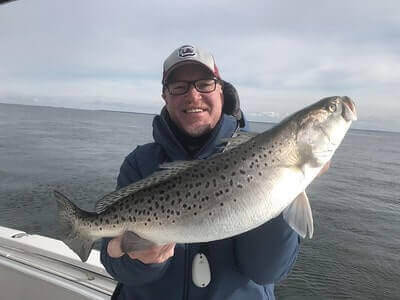
How To Catch Spotted Sea Trout In Florida
Spotted sea trout are often found around grass flats, mud flats, boat docks, mouth creeks, basins, mangroves, and oyster bars. Baits and lures can be used when fishing for spotted sea trout in Florida.
Drift fishing, casting, trolling, and jigging can be used when fishing for spotted sea trout in Florida. Shrimp, mullet, and pin fish are some of the baits you can use when fishing for spotted sea trout.
Best Baits & Lures For Spotted Seatrout
1. Soft Plastic Shrimp
Soft plastic shrimp lures are highly effective for targeting spotted seatrout, mimicking one of their favorite prey items. These lures are typically designed to closely resemble the appearance and swimming action of real shrimp, with detailed body shapes, segmented tails, and often featuring realistic colors and patterns.
Anglers can rig soft plastic shrimp lures on jig heads or weighted hooks, allowing them to be cast accurately to areas where spotted seatrout are likely to be feeding, such as along grassy flats, around oyster beds, or near structures like docks and bridges.
Retrieving the lure with a slow, twitchy action or with occasional pauses can imitate the natural movements of live shrimp, enticing strikes from hungry seatrout. Soft plastic shrimp lures offer anglers versatility in presentation and are particularly effective in shallow water where spotted seatrout are known to hunt for their prey.
2. Plastic Tail Grub Jigs
Plastic tail grub jigs are a popular and effective lure choice for targeting spotted seatrout. These lures typically consist of a soft plastic body with a curly or paddle tail design, which creates enticing vibrations and lifelike swimming action in the water.
The grub body can come in various sizes and colors, allowing anglers to match the hatch or experiment with different presentations based on prevailing conditions and the preferences of the fish. Plastic tail grub jigs are often rigged on jig heads with appropriate weights to help them sink to the desired depth and maintain control during retrieval.
Anglers can cast these lures to areas where spotted seatrout are likely to be feeding, such as around grass beds, sandbars, or drop-offs, and then retrieve them with a steady or erratic motion to simulate the movements of injured baitfish. The enticing action and realistic appearance of plastic tail grub jigs make them effective for enticing strikes from spotted seatrout in a variety of fishing scenarios.

3. Soft Plastic Jerk Baits
Soft plastic jerk baits are highly effective lures for targeting spotted seatrout in a variety of fishing conditions. These lures typically mimic the appearance and movement of injured baitfish, making them irresistible to hungry seatrout.
Soft plastic jerk baits are designed with a slender body and a soft, supple texture that imparts a natural swimming action when retrieved through the water. Anglers can rig these baits weedless or on jig heads to suit the depth and structure of the fishing area.
When fishing with soft plastic jerk baits, anglers can employ a variety of retrieval techniques, including jerking the lure with sharp twitches of the rod tip to impart erratic movements or reeling it in steadily to mimic the smooth swimming motion of a healthy baitfish.
These versatile lures can be effective when cast along grassy flats, around oyster beds, or near shoreline structures where spotted seatrout are known to congregate. With their lifelike appearance and enticing action, soft plastic jerk baits are a go-to option for anglers targeting trophy-sized spotted seatrout.
4. Topwater Plugs
Topwater plugs are a thrilling and effective lure choice for targeting spotted seatrout, especially during low-light conditions or in shallow water. These lures are designed to mimic injured baitfish or other surface-dwelling prey, creating irresistible surface disturbances that attract predatory fish like spotted seatrout.
Typically equipped with treble hooks and a concave or cupped face, topwater plugs produce enticing splashes, pops, or chugging sounds as they are retrieved across the water’s surface. Anglers can vary their retrieval speed and cadence to simulate different types of prey movements, enticing strikes from hungry seatrout.
Topwater plugs are particularly productive when cast along marshy shorelines, around grass beds, or over submerged structures where seatrout lurks in ambush. The explosive surface strikes elicited by topwater plugs make for an exhilarating fishing experience, making them a favorite among anglers targeting spotted seatrout in shallow coastal waters.
Use “walk the dog” topwater plugs to catch spotted seatrout during the morning or evening hours on shallow flats.

5. Spoons
Spoons are a classic and versatile lure option for targeting spotted seatrout in a variety of fishing environments. These metal lures feature a curved, concave shape that produces an enticing wobble and flash when retrieved through the water.
Spoons come in various sizes, colors, and designs, allowing anglers to match the local baitfish species and environmental conditions. When targeting spotted seatrout, anglers often opt for smaller to medium-sized spoons, typically ranging from 1/4 to 3/4 ounces, to mimic the size of the trout’s natural prey.
Spoons can be retrieved at various speeds, from a slow and steady retrieve to a fast, erratic action, allowing anglers to experiment and find the presentation that triggers strikes. These lures are effective when cast along grass flats, around oyster bars, or near channel edges where spotted seatrout are known to feed. The flash and vibration produced by spoons make them highly effective for covering water and enticing strikes from hungry seatrout, making them a staple lure in many anglers’ tackle boxes for spotted seatrout fishing.
6. Shrimp
Shrimp is a highly effective and widely used bait for targeting spotted seatrout, also known as speckled trout. These predatory fish are known to feed on shrimp, making it a natural and enticing option for anglers.
When rigged properly, live or fresh-dead shrimp can be irresistible to seatrout. Anglers often rig shrimp on a hook using various methods, such as threading it onto a jighead, hooking it through the tail or head, or using a Carolina rig to allow the shrimp to swim freely.
Additionally, artificial shrimp lures, such as soft plastics or hard-bodied imitations, are popular among anglers targeting seatrout. When fishing with shrimp, anglers typically focus on areas with structure or cover, such as grass flats, oyster beds, mangrove shorelines, and deep channels, where seatrout are likely to be hiding and feeding.
By presenting shrimp in these areas with subtle movements, anglers can entice strikes from hungry spotted seatrout, making it a go-to bait choice for many anglers pursuing these prized game fish.
7. Small Bait Fish
Small baitfish, such as finger mullet, pilchards, or menhaden, are highly effective bait options for targeting spotted seatrout. These predatory fish are naturally drawn to the movement and scent of small baitfish, making them a preferred meal option.
Anglers often use live or fresh-dead baitfish when targeting seatrout, either free-lined or rigged with a popping cork or Carolina rig to keep them at the desired depth in the water column. Additionally, artificial lures that mimic the appearance and movement of small baitfish, such as soft plastic swimbaits or hard-bodied plugs, can be equally effective in enticing strikes from seatrout.
When fishing with small baitfish, anglers typically target areas with structure, such as grass flats, mangrove shorelines, docks, or channel edges, where seatrout are known to congregate and ambush their prey. By presenting small baitfish in these areas with natural movements, anglers can increase their chances of enticing strikes from spotted seatrout, making them a valuable bait option for anglers pursuing these popular game fish.
8. Pinfish
Pinfish are commonly used as bait for targeting spotted seatrout, particularly in coastal and estuarine environments where these fish are abundant. Their small size and lively swimming motion make them enticing prey for spotted seatrout, which are known to feed on a variety of baitfish species.
Anglers often rig pinfish on a hook using a Carolina rig or a popping cork to keep them suspended at the desired depth in the water column. Pinfish can also be used live or dead, depending on angler preference and fishing conditions.
When fishing with pinfish, anglers typically target areas with structure, such as grass flats, mangrove shorelines, or oyster beds, where seatrout are known to congregate. By presenting pinfish in these areas with natural movements, anglers can effectively attract strikes from spotted seatrouts and increase their chances of success on the water.
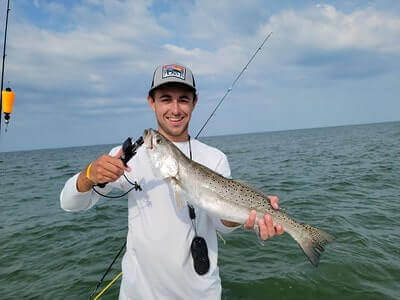
Spotted Seatrout Tackle
A 2500 series reel and a 7-foot medium action rod with a 10-pound braid and a 15-pound leader is a good tackle for catching spotted seatrout.

Spotted Seatrout Fishing Tips
1. The clarity of the water plays a major role in catching spotted seatrout. The clearer the water, the better your chances of catching spotted seatrout.
2. Shrimp is one of the best live bait to use to catch spotted seatrout.
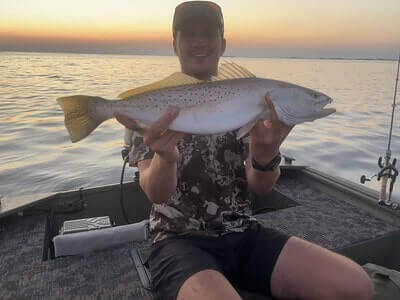
3. Get a saltwater fishing license and check your state’s saltwater fishing regulations concerning lengths and bag limits for spotted seatrout.
4. When the tide is rising, focus on shallow grass, and when it begins to fall, concentrate on channels and holes nearby.

5. When you are using plastic jigs, a 6 1/2 or 7-foot medium action spinning rod rigged with a 12-pound test monofilament fishing line and a 20-pound fluorocarbon leader line will work for catching spotted seatrout.
6. A 2500 series reel and a 7-foot medium action rod with a 10-pound braid and a 15-pound leader can work well for catching spotted seatrout.
7. Spotted Seatrout like to move into mudflats and oyster bars with the incoming tide as a school and feed on small bait fish, and shrimp.
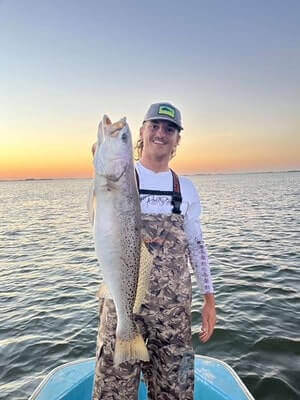
8. You can also find spotted seatrout around boat docks.
9. You can also find spotted seatrout around creek mouths and turning basins.
10. Fish for spotted seatrout in tidal creeks. They like to hunt for shrimps, crabs, and small bait fish during high tide in the tidal creeks.

11. Target the sandy potholes in the grass flats. Spotted seatrout uses the sandy holes as ambush points to catch shrimp, pinfish, and small bait fish. Drifting a grass flat is one of the best ways to catch spotted seatrout.
12. Spotted seatrout is a schooling fish.
13. A live bait under a popping cork is usually very effective.
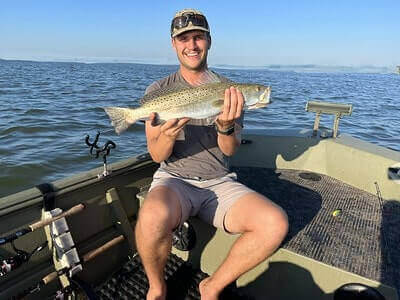
14. Dead bait also works well to catch spotted seatrout.
15. Spotted seatrout likes small scented jigs.
16. Don’t handle spotted seatrout with dry hands. Always wet your hands before grabbing the spotted seatrout to remove the hooks from their mouths.
17. Spotted seatrout has an excellent sense of smell.
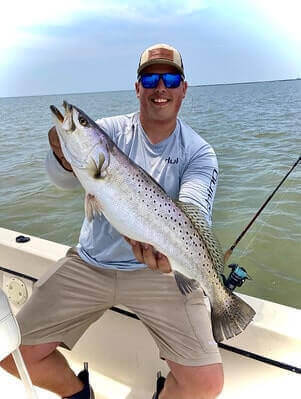
18. Fish for spotted seatrout in shallow areas early in the morning and late in the evening.
19. Spotted seatrout will hit topwater bait when clouds cover the sun and cast shade on the water.
20. When the water temperature is 50 degrees or lower, slowly work your lures and scale down on your gear as well.
The Bottom Line
Spotted seatrout is one of the favorite inshore gamefishes of anglers along the Atlantic and Gulf coasts. They can often be found near grass flats, mudflats, and oyster bars and are good to eat. The spotted seatrout is a school fish and is a great fish for eating.
In this article, we discussed how to catch spotted seatrout. If you are also interested in catching walleye, then read the walleye fishing tips. You can also read how to catch snook, how to catch tautog, how to catch whiting, how to catch ladyfish, how to catch sand seatrout, how to catch salmon, how to catch Artic Char, and how to catch croaker.